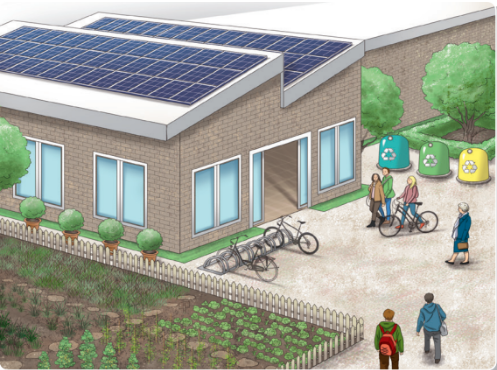Tiếng Anh 11 Unit 4 4.3 Listening1. In pairs, read VIỆT NAM TODAY and discuss the questions. 2. In pairs, look at the picture of an eco-school. Which features from the box would you expect it to have? 3. Listen to an interview about a project for an eco-school. Which features from Exercise 2 are mentioned? 4. Listen again and choose the correct answer, A, B or C. 5. Complete the sentences with the correct words in the box.
Lựa chọn câu để xem lời giải nhanh hơn
Bài 1 1. In pairs, read VIỆT NAM TODAY and discuss the questions. (Theo cặp, đọc VIỆT NAM NGÀY NAY và thảo luận các câu hỏi.) 1. What are your top three environmental worries? (Ba lo lắng hàng đầu của thanh thiếu niên Việt Nam là gì?) 2. What do you recycle, turn off and do more or less of to protect the environment? (Bạn tái chế, tắt và làm gì nhiều và ít hơn để bảo vệ môi trường?) VIET NAM TODAY Did you know that a majority of Vietnamese people admit that they are worrying about environmental problems in Viêt Nam and they think they should do more to protect the environment? What are Vietnamese teenagers' top three environmental worries? • Poor air quality • Global warming • Not enough recycling What do Vietnamese teenagers say they can do? • Recycle more • Turn off unnecessary lights • Spend less time in the shower Phương pháp giải: Tạm dịch: VIỆT NAM NGÀY NAY Bạn có biết rằng phần lớn người Việt Nam thừa nhận rằng họ lo lắng về các vấn đề môi trường ở Việt Nam và họ nghĩ rằng họ nên làm nhiều hơn nữa để bảo vệ môi trường? Ba lo lắng hàng đầu về môi trường của thanh thiếu niên Việt Nam là gì? • Chất lượng không khí kém • Sự nóng lên toàn cầu • Không tái chế đủ Thanh thiếu niên Việt Nam nói họ có thể làm gì? • Tái chế nhiều hơn • Tắt các đèn không cần thiết • Dành ít thời gian hơn khi tắm Lời giải chi tiết: 1. • Poor air quality (Chất lượng không khí kém) • Global warming (Sự nóng lên toàn cầu) • Not enough recycling (Không tái chế đủ) 2. I will recycle the old items, turn off the unnecessary lights and spend less time in the shower to protect the environment. (Tôi sẽ tái chế những món đồ cũ, tắt những bóng đèn không cần thiết và dành ít thời gian hơn khi tắm để bảo vệ môi trường.) Lời giải chi tiết: Đang cập nhật! Bài 2 2. In pairs, look at the picture of an eco-school. Which features from the box would you expect it to have? (Theo cặp, nhìn vào bức tranh về một ngôi trường sinh thái. Những đặc điểm nào trong hộp bạn muốn nó có?)
Lời giải chi tiết: - low-energy light bulbs (bóng đèn năng lượng thấp) - an organic vegetable garden (vườn rau hữu cơ) - recycling bins (nhiều thùng rác) - solar panels (tấm năng lượng mặt trời) Bài 3 3. Listen to an interview about a project for an eco-school. Which features from Exercise 2 are mentioned? (Nghe một cuộc phỏng vấn về một dự án cho một trường học sinh thái. Những đặc điểm nào từ Bài tập 2 được đề cập?) Lời giải chi tiết: - low-energy light bulbs (bóng đèn năng lượng thấp) - an organic vegetable garden (một khu vườn rau củ hữu cơ) - recycling bins (thùng rác tái chế) - science lessons on global warming (những bài học khoa học về nóng lên toàn cầu) - solar panels (những tấm pin năng lượng mặt trời) - technology lessons on renewable energy (những bài học công nghệ về nguồn năng lượng tái tạo) Bài 4 4. Listen again and choose the correct answer, A, B or C. (Nghe lại và chọn câu trả lời đúng A, B hoặc C.) 1. 'Friends of the Planet' is an after-school club with members from ('Những người bạn của hành tinh' là một câu lạc bộ sau giờ học với các thành viên từ) A. one school. (một trường.) B. seven schools. (bảy trường.) C. six schools. (sáu trường.) 2. The aim's project is (Mục đích của dự án là) A. to make environmentally-friendly changes tonschools. (để thực hiện những thay đổi thân thiện với môi trường trong trường học.) B. to create a new type of solar panel for schools. (để tạo ra một loại tấm pin năng lượng mặt trời mới cho các trường học.) C. to help design a new environmentally-friendly school. (để giúp thiết kế một ngôi trường mới thân thiện với môi trường.) 3. School dinners will include vegetables from (Bữa tối ở trường sẽ bao gồm các loại rau từ) A. a local farm. (một trang trại địa phương.) B. the local supermarket. (siêu thị địa phương.) C. the school garden. (vườn trường.) 4. Science and technology lessons will (Bài học khoa học và công nghệ sẽ) A. be the same as in other secondary schools. (giống như ở các trường trung học cơ sở khác.) B. not focus on climate change. (không chú trọng đến biến đổi khí hậu.) C. concentrate a lot on environmental issues. (tập trung nhiều vào vấn đề môi trường.) 5. The interviewer comments that (Người phỏng vấn nhận xét rằng) A. Michael is probably not a typical teenager. (Michael có lẽ không phải là một thiếu niên điển hình.) B. Michael is like every other student of his age. (Michael giống như mọi học sinh khác ở độ tuổi của anh ấy.) C. Michael likes games and gadgets. (Michael thích trò chơi và phụ tùng.) Lời giải chi tiết:
Bài 5 5. Complete the sentences with the correct words in the box. (Hoàn thành các câu với các từ đúng trong hộp.)
1. Solar panels make buildings look ugly. 2. There aren't enough recycling ______ in my area. 3. Climate ______ doesn't affect my country. 4. More renewable ______ is the only way to stop global 5. Everybody should use low-energy light ______ to save electricity. 6. Our government is not interested in environmental ______. Phương pháp giải: bins: thùng bulbs: bóng đèn change: thay đổi energy: năng lượng issues: vấn đề panels: tấm warming: sự nóng lên Lời giải chi tiết:
1. Solar panels make buildings look ugly. (Các tấm pin mặt trời làm cho các tòa nhà trông xấu xí.) 2. There aren't enough recycling bins in my area. (Không có đủ thùng rác tái chế trong khu vực của tôi.) 3. Climate change doesn't affect my country. (Biến đổi khí hậu không ảnh hưởng đến đất nước của tôi.) 4. More renewable energy is the only way to stop global. (Nhiều năng lượng tái tạo hơn là cách duy nhất để ngăn chặn toàn cầu.) 5. Everybody should use low-energy light bulbs to save electricity. (Mọi người nên sử dụng bóng đèn năng lượng thấp để tiết kiệm điện.) 6. Our government is not interested in environmental issues. (Chính phủ của chúng tôi không quan tâm đến các vấn đề môi trường.) Bài 6 PRONUNCIATION FOCUS: STRESS IN WORDS WITH THREE OR FOUR SYLLABLES (TRỌNG TÂM PHÁT ÂM: TRỌNG TÂM TRONG CÁC TỪ CÓ BA HOẶC BỐN ÂM TIẾT) 6. Listen and put the words in the box in the correct group, A, B, C or D, depending on the stress. Listen again and repeat. (Nghe và xếp các từ trong hộp vào đúng nhóm, A, B, C hoặc D, tùy thuộc vào trọng âm. Nghe lại và lặp lại.)
Lời giải chi tiết:
>> 2K9 Học trực tuyến - Định hướng luyện thi TN THPT, ĐGNL, ĐGTD ngay từ lớp 11 (Xem ngay) cùng thầy cô giáo giỏi trên Tuyensinh247.com. Bứt phá điểm 9,10 chỉ sau 3 tháng, tiếp cận sớm các kì thi.
|























